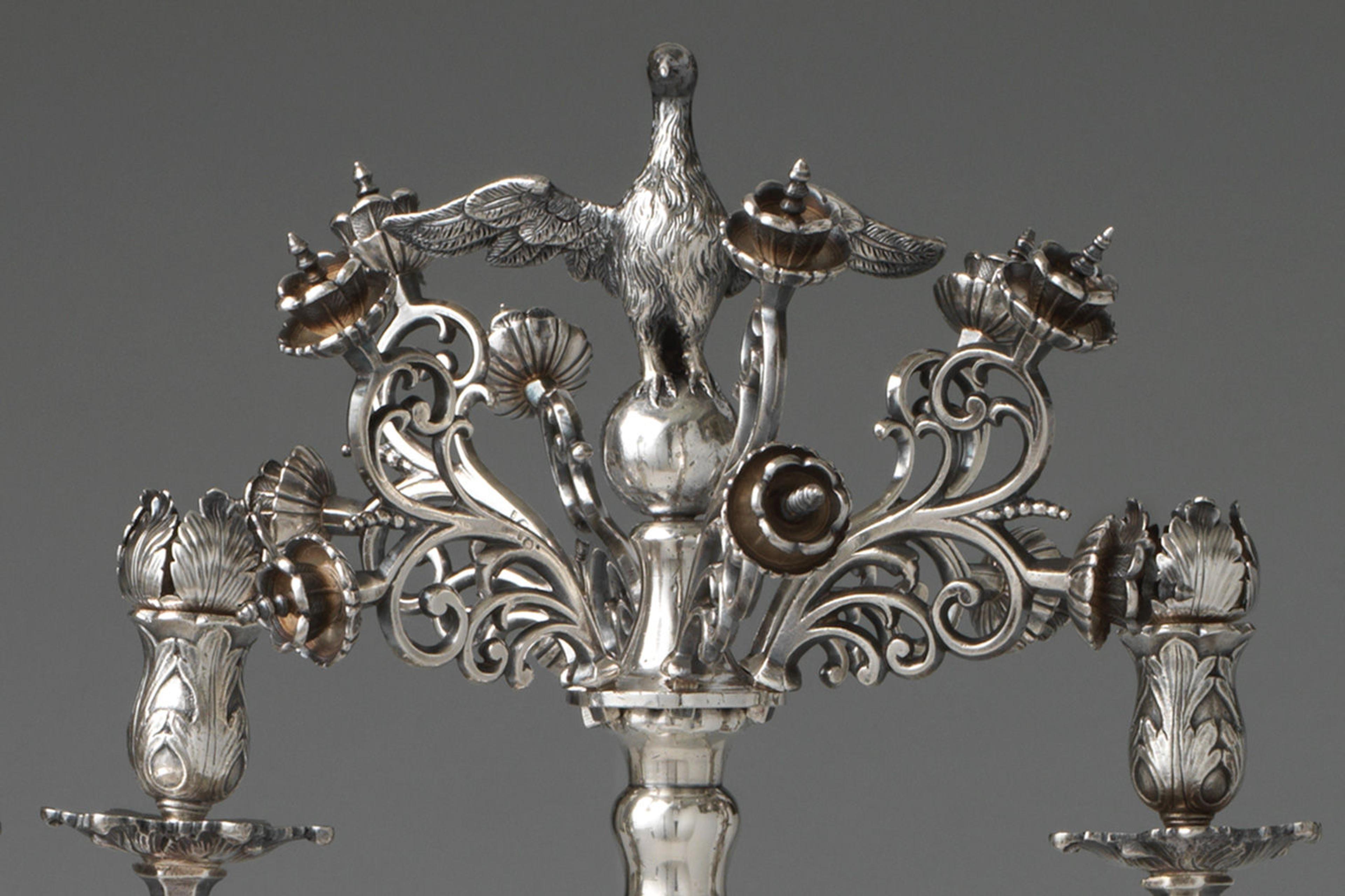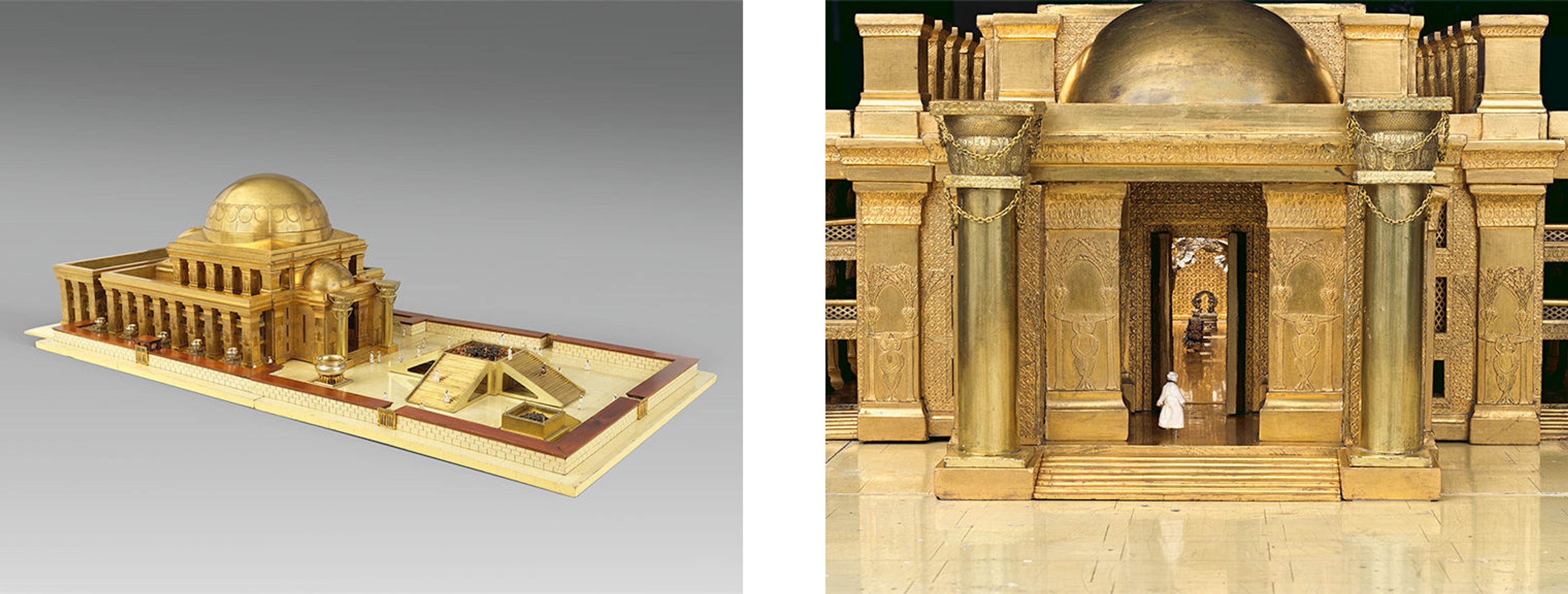Two Celebrations in One: An Eighth-Year Loan and the Eight-Day Festival of Hanukkah

Detail of Hanukkah lamp, 1866–72. Polish, Lviv (Lvov or Lemberg). Silver: cast, chased and engraved, 33 9/16 x 23 1/8 in. (85.3 x 58.7 cm). On loan from The Moldovan Family Collection
Celebrate Hanukkah at The Met this holiday season with a visit to this magnificent silver menorah on display in gallery 556. Created from 1866 through 1872 in Lemberg (Lviv), Eastern Europe, this lamp is generously on loan from the Moldovan Family Collection for the eighth year in a row—a significant number for the eight-day festival of Hanukkah. This year, the Jewish holiday begins on the evening of Sunday, December 22, and ends at sundown on Monday, December 30.
The central ceremony of Hanukkah is the lighting of a Hanukkah lamp, also known as a menorah. During the Jewish Festival of Lights, one candle is lit each night to commemorate the special menorah that was lit in the Holy Temple, and to recall a miracle connected with that lamp, when a single day's worth of oil lasted for eight days.

Hanukkah lamp, 1866–72. Polish, Lviv (Lvov or Lemberg). Silver: cast, chased and engraved, 33 9/16 x 23 1/8 in. (85.3 x 58.7 cm). On loan from The Moldovan Family Collection
The Hebrew inscription at the base of this lamp, which reads in English: "With You is the fountain of life, by Your light do we see light (Psalms 36:10)," signals the function of the lamp and characterizes the liveliness of its decoration and shimmering silver. Four miniature lions, overshadowed by the sheer grandeur of the lamp, mightily hold up the base. An eagle finial with outstretched wings crowns the piece and invites the viewer to light the lamp. Exquisite flowers elegantly blossom from the lamp's lower shaft.

Architectural model of the temple of King Solomon in Jerusalem, 1883. After a design by Thomas Newberry. Carved and gilded by Messrs. Bartlet, King Street, London. Gilded silver and brass appurtenances by W. Spurrier. British, London. Gilded wood, gilded carton pierre; gilded silver, gilded bronze; enamel, linen. 7 ft. 8 in. x 3 ft. 8 in. (234 x 112 cm). The Metropolitan Museum of Art, New York, Gift of Albert Kalimian, in honor of Victoria Kalimian and in memory of Rouhollah Kalimian, and in celebration of the Museum's 150th Anniversary, 2019 (2019.66.1a–o–.95)
Alternating flowers and buds applied to this lamp draw inspiration from the holy menorah (consisting of seven candles) built for the portable sanctuary, called the tabernacle, in the desert (Exodus 25: 31–40). Ten lampstands were also made for the First Temple, built by King Solomon, in Jerusalem. Such stands are present in the interior of the recently installed architectural model of Solomon's Temple just across from the Lemberg lamp. This model, made in Victorian England, reimagines the ancient Temple of the Israelites. Priestly figures, dressed in long white robes, ambulate around the sacrificial altar of the temple's grand atrium. The High Priest, standing between the twin pillars of the portico, greets the viewer with classical gravitas. A prominent dome with stylized palm trees crowns the majestic temple.
Hanukkah lamps can be rendered in different materials and can be comprised of diverse forms and motifs. The lamps can be small or large (at nearly three feet tall, this lamp is quite large!) depending on the intended use of the lamp—for a home or for a synagogue. Styles vary, too, based on region and period of production.

Baraffael Family Hanukkah Lamp, 1773–75. Gaspare Vanneschi (Italian, 1758–1787). Italian, Rome. Silver, embossed, engraved, punched; soft wood back support, 16 9/16 x 11 9/16 x 3 3/4 in. (42 x 29.4 x 9.5 cm). The Metropolitan Museum of Art, New York, Purchase, Acquisitions Fund, Friends of European Sculpture and Decorative Arts Gifts, Renée E. and Robert A. Belfer, Leon D. and Debra R. Black, Betsy and Ed Cohen/Arete, Mr. and Mrs. Mark Fisch, Álvaro Saieh Bendeck, Ruth and Andrew Suzman, Ann Tenenbaum and Thomas H. Lee, and Merryl H. and James S. Tisch Gifts, 2018 (2018.89)
The Baraffael lamp, for example, is a hanging wall lamp rather than the candelabrum form of the Lemberg lamp. And its motifs are different and personalized, too: a rooster holding a stalk of wheat in its beak appears in the cartouche at the lamp's top register. This motif is a crest for the Baraffael family, the Jewish family that commissioned this lamp. In the register below, a tipped oil jug commemorates the Hanukkah miracle. The small bees that swarm this jug are a tribute to Deborah Baraffael. (Deborah, which means "bee" in English, passed away about a decade before the piece was commissioned.) Stylized shells, which radiate from the jug, exhibit the prevailing Rococo style of the time throughout Europe. This lamp even looks ahead toward the Neoclassical style with the columns framing the central Hanukkah lamp. One could imagine when this lamp would be lit: the matte silver amplifying the light, and the multiple flames enriching the holiday spectacle.
The Met encourages visitors to enjoy these three Hanukkah-related objects in our galleries. The Met and the Department of European Sculpture of Decorative Arts are grateful to the Moldovan family for sharing their Hanukkah lamp with the Museum, and its visitors, for yet another Hanukkah.
Related Content
Learn more about Judaism in The Met collection on the Heilbrunn Timeline of Art History.
Explore a Spanish Hebrew Bible on MetCollects.
Abigail Rapoport
Abigail Rapoport is a research associate for Judaica in the Department of European Sculpture and Decorative Arts.